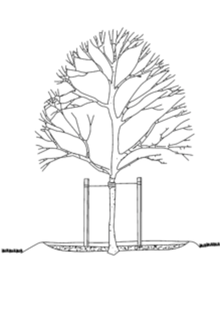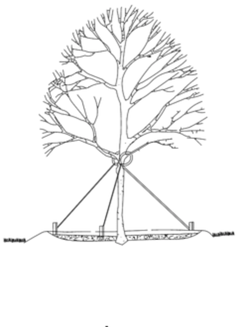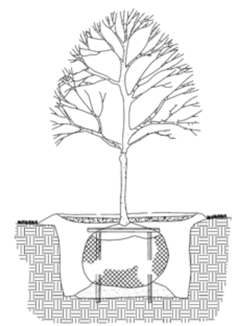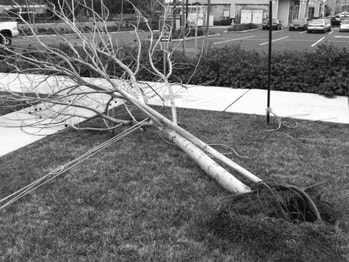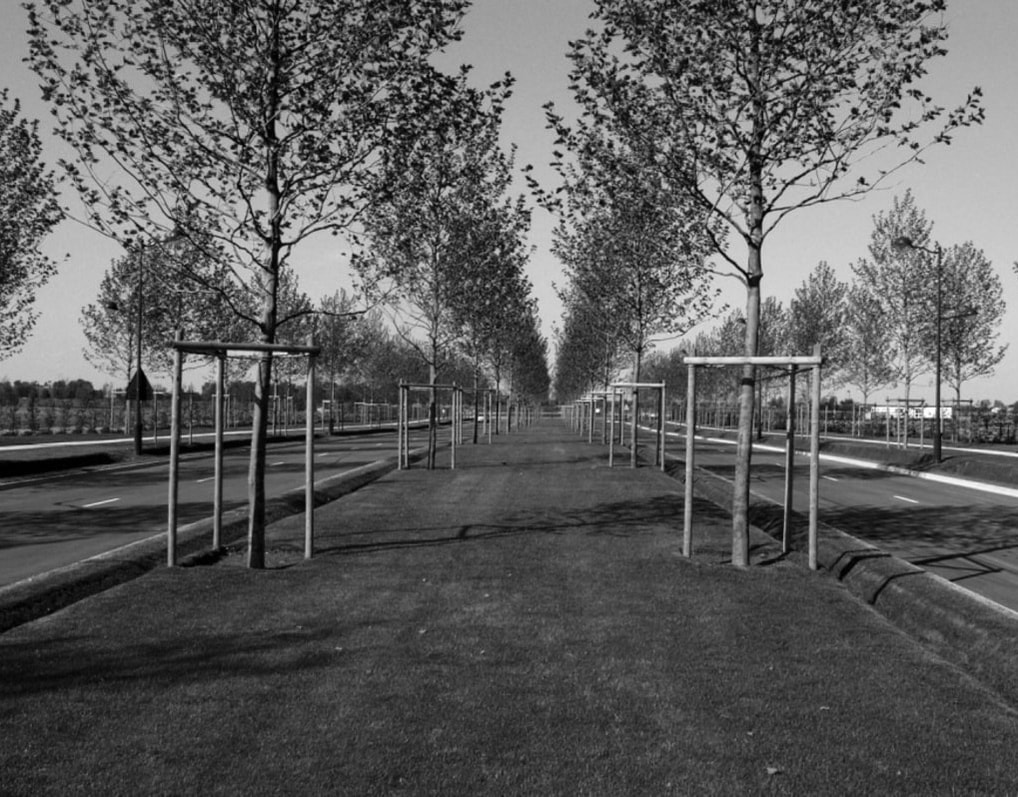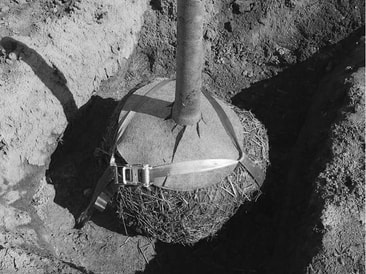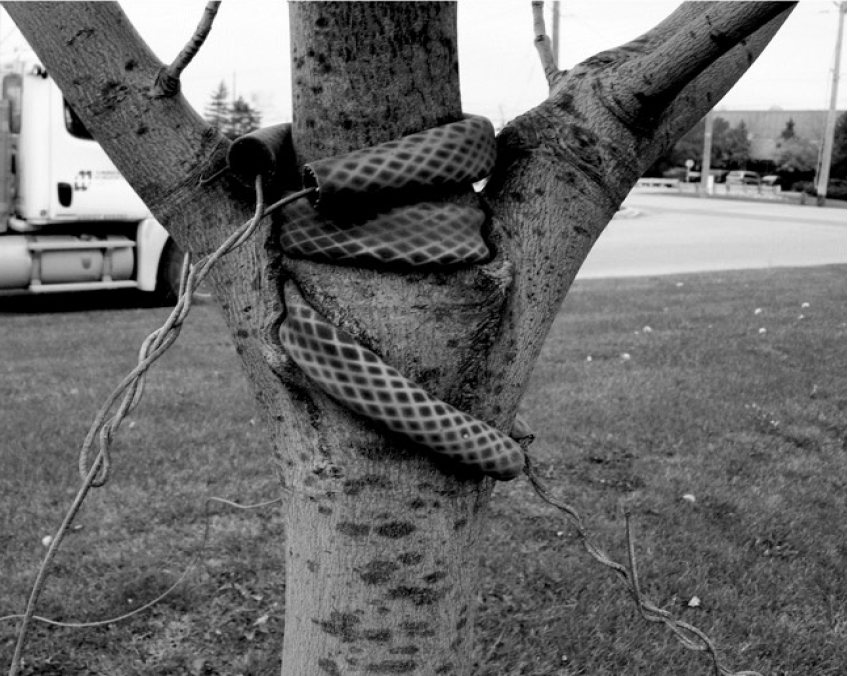Staking Your Newly Planted Trees
Website authored by: Frank Herbolsheimer
Myth: Newly planted tree should always use a tree stabilization system (1)
INTRODUCTION: Newly planted trees located in the urban landscape are commonly supported with staking or guying systems (2). This assumption is believed because it is a popular practice that is a commonly used and misunderstood throughout the tree care industry (3). Many manufactures sell products and use different techniques that help physically support young trees; however, these systems are not always necessary and can be detrimental to the health of the tree (4). A homeowner might assume that staking a tree makes the tree stronger and more stable, when in fact the support could be negatively affecting the development of the tree. The terminology used to describe these systems use words like “support” and “stabilization” which can also be misleading to homeowners and landscape professionals. Some landscape professional use a tree stabilization system to prevent them from coming back to the location to fix a tree that might be damaged (3). Oftentimes, tree stabilization system are widely seen on newly planted trees because it is written in specifications or details (2). This article will cover the impact tree stabilization systems have on the roots, trunk, and growth of a tree and discuss what, when, why, and how to use tree stabilization systems.
WHAT IS A TREE STABILIZATION SYSTEM:
|
STAKING
is using two or more wooden or medal stakes driven into the ground and connected to the trunk
|
GUYING
is used on trees greater than 4" caliper trees where wires are staked into the ground at an angle
|
ROOT BALL ANCHORING
is an underground system used on bald and burlap trees using stakes in the root ball
|
WHY USE A TREE STABILIZATION SYSTEM:
There are two major reasons people use tree stabilization systems, physical support and protection from potential harms (4).
There are two major reasons people use tree stabilization systems, physical support and protection from potential harms (4).
|
Physical Support
|
Protection
Tree stabilization systems provide a physical barrier between the tree and potential harms
Maintenance practices:
|
DISADVANTAGES OF USING A TREE STABILIZATION SYSTEM:
Tree stabilization systems do have disadvantages if installed improperly or left on for too long (4).
Tree stabilization systems do have disadvantages if installed improperly or left on for too long (4).
|
Tree Growth Defect:
|
Aesthetics:
|
WHAT THE SCIENCE SAYS:
Many affects have been observed in young tree’s roots and trunks when comparing young trees that have used a tree stabilization system to those that have not.
Many affects have been observed in young tree’s roots and trunks when comparing young trees that have used a tree stabilization system to those that have not.
|
ROOTS:
The roots of a tree serve four functions including, anchorage, storage, absorption, and conduction. The root system of a tree must be strong enough to withstand and dissipate forces such as wind and snow. To prevent uprooting of a young tree, natural forces like wind move down the tree trunk to the roots. A strong root system is essential for the long-term health of a tree. In some studies young trees using a tree stabilization systems developed smaller root systems compared to those that do not. Stabilized trees had less dry root mass than non-stabilized trees, also, the area, depth, and volume of soil occupied by the roots was significantly less for staked trees (4). Other studies showed tree stabilization systems had no effect on root diameter, root length, or root mass (4). When planting a tree it is important to select the right tree for the right place. Different species and environmental conditions will also affect whether a tree will thrive or not. |
|
TRUNK:
Under natural conditions the trunk of a tree forms a trunk taper that is thicker at the base and decreases as you move up the trunk. Trunk taper is important because it enables the tree to withstand the forces of wind (7). To develop a strong taper young trees need to be able to move or sway in response to the wind (7). The swaying of the trunk causes the tree to develop properly tapered wood. This is similar to lifting weights to strengthen muscles, trees grow more wood in response to the forces such as wind . Trees held too tightly by stabilization system do not develop a normal taper and, when the support is removed, they oftentimes lean, uproot, or break. Studies comparing different tree stabilization systems with a control the taper of staked trees increased in trunk caliper less than guyed or root ball anchored tree, but similar to the control trees. The taper of staked trees decreased during the growing season, which was different from guyed trees, for which trunk taper increased (4). Oftentimes, the materials used in tree support systems are not the proper material or installed too tightly, girdling the tree (7). Girdling involves pinching off the outer surface of a tree restricting the flow of nutrients and resources up the tree. Tree support systems left on a tree for longer than one year can girdle the trunk impairing the health or stunting the growth. |
HOW TO PROPERLY USE A TREE SUPPORT SYSTEM:
Tree support systems will not damage a tree if done correctly. Correct tree support systems involves using the proper number of stakes or guy lines, selecting the right materials, and installing the system in the correctly with the most effective and least damaging tying technique (6). The most important thing to remember is that the system must be removed as soon as it is no longer necessary (6). Figuring out when the right time to remove a tree support systems can be tricky. Studies show that five to seven weeks is typically the amount of time that a correctly installed tree support systems can provide stability for a young tree in order to establish (8). After one growing season the tree support systems starts to affect the development and can lead to other damages and can be significantly worse after two or more growing seasons (6). Trees located in windy areas are the best candidates for a support systems.
Tree support systems will not damage a tree if done correctly. Correct tree support systems involves using the proper number of stakes or guy lines, selecting the right materials, and installing the system in the correctly with the most effective and least damaging tying technique (6). The most important thing to remember is that the system must be removed as soon as it is no longer necessary (6). Figuring out when the right time to remove a tree support systems can be tricky. Studies show that five to seven weeks is typically the amount of time that a correctly installed tree support systems can provide stability for a young tree in order to establish (8). After one growing season the tree support systems starts to affect the development and can lead to other damages and can be significantly worse after two or more growing seasons (6). Trees located in windy areas are the best candidates for a support systems.
|
Steps to staking a tree (6):
1. After determining if a support system is needed, determine how many stakes are needed. 2. Gather proper materials
4. Tie each stake to the trunk with a loop or figure eight allowing some flexing of the tree without allowing movement of the roots or rubbing of the stakes against the trunk 5. Properly mark wires and stakes to warn people of their presence 6. Check back with the tree frequently and remove stakes after one growing season or when it is no longer necessary |
Steps to guying a tree (6):
1. After determining if a support system is needed, determine how many stakes are needed. 2. Gather proper materials
4. Tie each anchor to the trunk with a loop or figure eight allowing some flexing of the tree without allowing movement of the root. twist wires to tie them off 5. Properly mark wires and anchors to warn people of their presence 6. Check back with the tree frequently and remove anchors after one growing season or when the tree is established |
SUMMARY:
The site conditions, tree characteristics, planting practices, and location are all conditions that need to be taken into account when deciding whether or not to use a tree support system on a young tree. If a tree support system is used the person installing the system needs to be aware of the affects the system could have on the young tree. If using a tree support system correctly the system can provide temporary support for a young tree. Unfortunately, tree support system are oftentimes used in unnecessary situations or used incorrectly for an extended period of time causing life altering affects or even death. By using good judgment on whether or not to use tree support system for young trees, one can encourage strong growth and a healthy tree for years to come.
The site conditions, tree characteristics, planting practices, and location are all conditions that need to be taken into account when deciding whether or not to use a tree support system on a young tree. If a tree support system is used the person installing the system needs to be aware of the affects the system could have on the young tree. If using a tree support system correctly the system can provide temporary support for a young tree. Unfortunately, tree support system are oftentimes used in unnecessary situations or used incorrectly for an extended period of time causing life altering affects or even death. By using good judgment on whether or not to use tree support system for young trees, one can encourage strong growth and a healthy tree for years to come.
REFERENCES:
1. The Myth of Staking:"Newly planted trees should be staked firmly and securely". Linda Chalker-Scott.
2. Shafer, Thomas S.City of Lincoln Standard Specifications . 2017.
3. Evaluation of Landscape Tree Stabilization Systems. Gilman, Ryan Eckstein and Edward F.4, s.l. : International Society of Arboriculture, 2008, Arboriculture & Urban Forestry, Vol. 34, pp. 216-221.
4. Tree Stabilization: Current Products and Practices. Bonnie L. Appleton, Carolyn M. Cannella, P. Eric Wiseman, and Alexis A. Alvey.1, s.l. : International Society of Arboriculture, Arboriculture & Urban Forestry, Vol. 34, pp. 54-58.
5. Effects of Tree Stabilization Systems on Tree Health. Kendra J. Labrosse, Robert C. Corry, and Youbin Zheng.5, s.l. : International Society of Arboriculture, 2011, Arboriculture & Urban Forestry, Vol. 37, pp. 219-225.
6. Staking and Guying Newly Planted Trees. Hensley, Ginny Meade and David.s.l. : Cooperative Extension Service, 1998.
7. Staking Your Claim. Ball, John and Konda, Travis.3, 2000, American Nurseryman, Vol. 192, p. p66.
8. Efficacy of Conventional Tree Stabilization Systems and their Effect on Short-Term Tree Development. Alexis A. Alvey, P. Eric Wiseman, and Brian Kane.3 s.l. :International Society of Arboriculture, Arboriculture & Urban Forestry, Vol. 35, pp. 157-164.
9. Day, tip and tree. Permaculture Tip of the Day - Transplanting a Young Tree – School of Permaculture. School of Permaculture . 2018. Available from: https://schoolofpermaculture.com/permaculture-tip-day-bending-trees/
10. Image. 2018. Available from: https://www.ebben.nl/en/planting-and-managing-trees/anchoring-trees/
11. ROOT BALL - Underground rootball fixing system by Greenmax | ArchiExpo. Archiexpo.com. 2018. Available from: http://www.archiexpo.com/prod/greenmax/product-92582-1802908.html
1. The Myth of Staking:"Newly planted trees should be staked firmly and securely". Linda Chalker-Scott.
2. Shafer, Thomas S.City of Lincoln Standard Specifications . 2017.
3. Evaluation of Landscape Tree Stabilization Systems. Gilman, Ryan Eckstein and Edward F.4, s.l. : International Society of Arboriculture, 2008, Arboriculture & Urban Forestry, Vol. 34, pp. 216-221.
4. Tree Stabilization: Current Products and Practices. Bonnie L. Appleton, Carolyn M. Cannella, P. Eric Wiseman, and Alexis A. Alvey.1, s.l. : International Society of Arboriculture, Arboriculture & Urban Forestry, Vol. 34, pp. 54-58.
5. Effects of Tree Stabilization Systems on Tree Health. Kendra J. Labrosse, Robert C. Corry, and Youbin Zheng.5, s.l. : International Society of Arboriculture, 2011, Arboriculture & Urban Forestry, Vol. 37, pp. 219-225.
6. Staking and Guying Newly Planted Trees. Hensley, Ginny Meade and David.s.l. : Cooperative Extension Service, 1998.
7. Staking Your Claim. Ball, John and Konda, Travis.3, 2000, American Nurseryman, Vol. 192, p. p66.
8. Efficacy of Conventional Tree Stabilization Systems and their Effect on Short-Term Tree Development. Alexis A. Alvey, P. Eric Wiseman, and Brian Kane.3 s.l. :International Society of Arboriculture, Arboriculture & Urban Forestry, Vol. 35, pp. 157-164.
9. Day, tip and tree. Permaculture Tip of the Day - Transplanting a Young Tree – School of Permaculture. School of Permaculture . 2018. Available from: https://schoolofpermaculture.com/permaculture-tip-day-bending-trees/
10. Image. 2018. Available from: https://www.ebben.nl/en/planting-and-managing-trees/anchoring-trees/
11. ROOT BALL - Underground rootball fixing system by Greenmax | ArchiExpo. Archiexpo.com. 2018. Available from: http://www.archiexpo.com/prod/greenmax/product-92582-1802908.html
